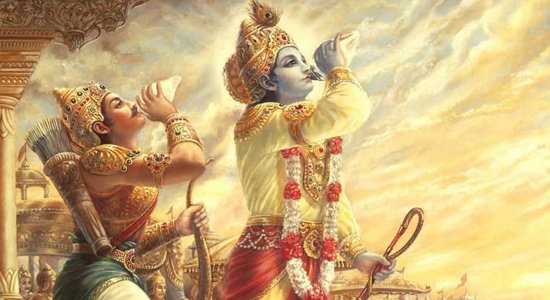
It’s frequently said that yoga finds us, not the other way around.
When we are ready to benefit from what yoga offers, something in the cosmos or our lives replies by sending us an invitation. It is entirely up to us whether or not we accept that offer, and the degree to which we do so typically reflects the views we hold about yoga.
Yoga’s name means “connecting with God” at first. This suggests that any sincere yoga method should incorporate spirituality, regardless of how different it may be. For instance, Lord Krishna discusses the contemplative life and the active life, two types of spirituality that could be related to yoga, in the first lines of the third chapter of the Gita.
Extreme acts of renunciation were required of the Indian populace at the time the Gita was written. In their opinion, one could only approach a life of the spirit by letting go of the weight of an active worldly existence.
BHAGAVAD GITA AND YOGA
As described in the Bhagavad Gita, yoga is a practice that almost every person engages into some extent and is unaware of. The many ways to practice yoga and the goals of those practices were intimately interwoven in early yoga literature. It’s as if yoga were urging us to focus on the current moment of our practice rather than on the future, the benefits of yoga for us, or where it might go.
The word yoga first appears in the Bhagavad Gita, a key yoga scripture, as a remedy Krishna offers Arjuna for overcoming his unwillingness to participate in his life.
Krishna offered yoga to Arjuna as a different way of being after he had reached the depths of despair. When Arjuna was most trapped, Krishna, his charioteer companion, brought yoga to him. What, therefore, does Krishna define as yoga?
In the Bhagavad Gita, Krishna mentions yoga more than 100 times, so he has a lot to say about it! The Sanskrit term for yoga, yukta, appears in the Bhagavad Gita’s original text seventy-eight times as a noun and thirty-six times as a verb. When we consider how Krishna describes yoga in the Bhagavad Gita, everyone is engaged in yoga! The Gita’s description of yoga is deep, intricate, and colorful, encompassing many aspects of life and humanity.
1. Yoga is a clear-headed, discerning, completely voluntary, and active way of living.
Krishna describes yoga in the beginning as a clear judgment that will release one from feeling compelled to do action.
Krishna underlines the value of action that does not consider the fruits one might gain from that activity in a direct response to Arjuna’s inaction.
Krishna also explains that yoga is a lifestyle that requires active involvement, not merely thinking (as in Sankhya’s teachings).
2. Yoga is the archetypal light fuelled by love; it is eternal, primal, and revealing.
The startling revelation that the yoga Krishna provides Arjuna is the same yoga he gave the sun god, Vivasan, begins the Bhagavad Gita.
In this context, the timeless, auditory transmission and light are all tied to yoga.
Like the sun, it is revered and trusted by all life on our planet.
Only losing sight of the sun can eventually blur our perception of yoga.
What becomes our compass when the light goes out, and we feel uninspired on our trip? What role does yoga play in our lives?
Krishna tells Arjuna in verse three of chapter four that we are discovered via love. Thus, it is highlighted that there is a connection between yoga, light, and our loving interactions with others.
3. Yoga is the offering that uplifts, inspires, and actively engages while doing so in a way that is in harmony with all other living things.
The lines where Krishna uses the word “yoga” or “yukata” specifically speak about sacrifice, or the voluntarily giving up something of lesser worth in exchange for something of higher value.
This is intriguing after Krishna explains the need for love in yoga practice. Then he talks about putting one’s breath and senses’ actions into “the fire of yoga.”
According to Krishna, “the one who attains imperishable delight through yoga is one whose ego is engaged in the yoga of Brahman.”
4. Yoga is a vision of peaceful interconnectedness with all life around us. It is altruistic, purifying, liberating, balancing, inspirational, and joyously practiced.
More than any other subject in the Bhagavad Gita, Krishna devotes 29 verses to defining yoga—what it is, what it is not, plus what results in it produces.
He explains that practicing yoga requires giving up selfish intentions.
Then he highlights yoga motion as a requirement for being calm and still.
Yoga is defined as having no attachment to one’s thoughts, feelings, or deeds and no ulterior objectives other than “purification of the self.”
Yoga is a way to hold divinity in the highest regard. As Krishna advises Arjuna, fully immersing oneself in yoga “culminates in the greatest condition of Nirvana.” Yoga calms the mind and thoughts and frees one from suffering.
Yoga should be practiced with commitment and without thinking anything negatively. When doing yoga, one experiences unending delight and realizes that all beings are present in and parts of the Self.
5. In the presence of other yoga practitioners, the contributions of love and the insights they foster enrich yoga.
Krishna reassures Arjuna that a soul like that is born again to the “pure and wealthy” and that even someone who wants to learn yoga “transcends the sound of ultimate reality.”
The double meaning of these words and the obvious reference to reincarnation suggest the importance of surrounding oneself with other yoga practitioners to encourage and inspire one’s practice.
One’s yoga practice may feel like it has a fresh start after being “reborn” into such a corporation.
Yoga then leads one to Krishna. What does this mean in terms of a modern yoga practitioner’s life? When you perform yoga, who is Krishna?
Krishna continues by explaining what it means to know him “fully” and lists all the locations where he can be found:
6. Increased sensitivity to and awareness of all life, both outside and within us, as well as an outpouring of love in response to the wonder and beauty of life.
The flavor of water, the brightness of the moon and sun, the holy words found in all the Vedas, the sound of space, and the might of humanity are all ways we encounter Krishna.
The attributes in the cosmic components all around us, inside our bodies, and in the pure scent in the ground, the brightness in fire, life in all beings, austerities, seed in all beings, discernment, magnificence, power free of want and passion.
Then Krishna informs Arjuna that he attracts four different categories of people: those in need, those seeking enlightenment, those looking to gain personal advantage, and those who already possess wisdom.
Bhakti is the way our hearts are involved in our yoga practice.
7. Yoga is a journey that does not finish with death; it is brave and enlightening.
When acting as the yoga teacher, Krishna says that individuals constantly practicing yoga are delighting and honoring him with offers of love and striving with great devotion.
Krishna then guarantees prosperity and safety to people who have devoted their lives to yoga. And that he will undoubtedly encounter such souls.
8. A close relationship with the cosmos as a whole, everlasting worlds that extend beyond the manifested universe, and the limitless capacity for love within our beings.
What is the discernment that Krishna is referring to? How can someone committed to practicing yoga see the entire environment as fuel for their practice? Krishna elaborates and imbues the elements of fire, the radiance of the sun, the moon, the ocean, silent repeated prayer, the Himalayas, the thunderbolt, death, time, wind, the shark, the beginning, the middle, the spring season, courage, the silence of secrets, knowledge, beauty, and great power with his presence as the original yoga teacher.
9. Yoga is our link to the cosmos as a whole, to everlasting worlds that extend beyond the manifested universe, and to the limitless capacity for love inside our beings.
The most astounding aspect of this magnificent vision for any yoga practice is that Krishna claims that his universal form originated from the yoga he practiced as a human. Krishna himself even performs yoga, then!
Krishna responds that those whose thoughts are constantly focused on him and engaged in yoga are the ones who suffer.
Krishna then describes yoga once more as dedicating all deeds to him.
Krishna also describes yoga as “the unwavering giving of love” in chapter twelve, verse ten. And one who consistently serves me via the yoga of giving love, transcending these “qualities,” is preparing themselves to be unified with ultimate reality.
10. Yoga is a robust and unwavering energy that draws us toward the enigmatic and hidden and ties us to the marvel of being alive and of all life.
In his discourse, Krishna speaks of “steadfastness in the yoga of knowing.” Only eight verses in the Bhagavad Gita’s final three chapters use the words “yoga” or “yukta,” mostly describing those absorbed in yoga as reflecting the qualities of sattva, clarity, and purity. This is when the topic of energies that pull one toward and away from absorption in yoga begins.
The Bhagavad Gita comes to a triumphant conclusion with a fiery last verse that celebrates the success of individuals who connect themselves with a sincere, loving yoga practitioner and teacher, as Arjuna did with Krishna.
Stepping Up The Ladder
We can see that the Gita affirms the legitimacy of all classical yoga styles and claims they all emphasize union with the Supreme.
However, the Gita also establishes a hierarchy: first, comprehension, study, then meditation (dhyana-yoga).
These result in profound philosophical reflection, wisdom, and, ultimately, renunciation (sannyasa-yoga). The proper use of wisdom (buddhi-yoga), karma-yoga, and bhakti-yoga results through renunciation.
Understanding the transient character of the material world and duality is the first step in the lengthy inner development process required for all of this. The aspirant yogi begins to practice external renunciation and gradually internal renunciation after realizing that the world of matter will eventually vanish and that birth leads to death too quickly. This eventually entails giving up the desire for the results of one’s labor (karma-phala-tyaga) and performing the labor itself as an offering to God (bhagavad-artha-karma).
The “perfection of inaction” (naishkarmya-siddhi), or emancipation from the shackles of labor, is attained by this detached action technique (karma-yoga). Because one learns to labor as an “agent” rather than a “enjoyer,” one knows to work for God on His behalf, one is set free from such servitude. In its pages, Krishna guides Arjuna (and everyone of us) through each stage of the yoga process. This is the Gita’s central message.
